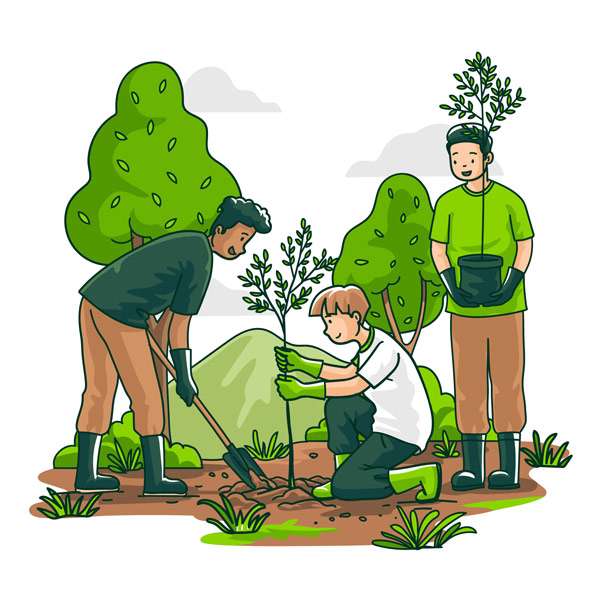In the ever-evolving landscape of the digital era, social media has emerged as a powerful tool with the potential to shape public opinion, influence change, and drive movements. One of the pressing issues demanding our attention is environmental conservation. Harnessing the capabilities of social media platforms to foster environmental awareness is not just an option;
In the ever-evolving landscape of the digital era, social media has emerged as a powerful tool with the potential to shape public opinion, influence change, and drive movements. One of the pressing issues demanding our attention is environmental conservation. Harnessing the capabilities of social media platforms to foster environmental awareness is not just an option; it’s a responsibility. This comprehensive guide delves into the intricacies of using your social media presence to champion environmental causes, offering a roadmap for individuals, influencers, and organizations seeking to make a meaningful impact.
Environmental Awareness Examples
Environmental awareness can take various forms, and individuals, organizations, and governments around the world have implemented creative initiatives to raise awareness about environmental issues. Here are some examples:
1. Earth Hour:
Earth Hour is a global event organized by the World Wildlife Fund (WWF) where millions of people around the world turn off their lights for one hour as a symbolic gesture to raise awareness about climate change. Participants are encouraged to use that hour to reflect on their energy consumption and environmental impact.

2. Climate Strikes and Youth-Led Movements:
Youth-led movements, such as Fridays for Future, initiated by Greta Thunberg, involve students and young people striking from school to demand stronger action on climate change. These protests draw attention to the urgency of addressing environmental issues and involve a demographic that will be significantly impacted by climate change.
3. Zero Waste Lifestyle Movement:
Influencers and individuals promoting a zero-waste lifestyle on social media platforms share their experiences, tips, and challenges in living with minimal environmental impact. This movement encourages people to reduce their waste, make sustainable choices, and adopt eco-friendly habits.

4. Green School Programs:
Many schools globally have initiated environmental education programs to raise awareness among students. These programs often include activities like tree planting, waste reduction campaigns, and educational sessions on conservation. Students are actively involved in hands-on projects to understand and address environmental issues.
5. Public Art Installations:
Public art installations, such as sculptures made from recycled materials or murals depicting environmental themes, serve as visual reminders of the importance of conservation. These installations can spark conversations and engage communities in thinking about their impact on the environment.
Impact of Social Media on Environmental Awareness
There are several ways in which social media has influenced environmental awareness. For example:
1. Global Reach and Instantaneous Communication:
Social media platforms provide a global stage for environmental issues, enabling information to reach audiences across the world instantly. News, images, and stories related to environmental challenges can spread rapidly, fostering a sense of global interconnectedness and shared responsibility.

2. Amplification of Environmental Campaigns:
Environmental campaigns and movements leverage social media to amplify their messages. Hashtags related to environmental issues allow users to participate in a collective online conversation. This amplification increases the visibility of campaigns, making them more likely to reach a broader and more diverse audience.
3. Real-Time Reporting and Updates:
Social media platforms serve as real-time reporting tools for environmental events and crises. From wildfires to natural disasters, users can share updates and firsthand accounts instantly.
4. User-Generated Content and Citizen Journalism:
Social media empowers individuals to become citizen journalists, documenting environmental issues in their communities. User-generated content, such as photos, videos, and personal stories, adds authenticity to environmental narratives and helps bridge the gap between scientific information and public understanding.
5. Educational Content and Infographics:
Social media is a platform for sharing educational content in easily digestible formats. For example: infographics, short videos, and concise posts break down complex environmental issues, making them accessible to a wider audience. Thus users can quickly grasp the significance of topics like climate change, deforestation, or pollution.

6. Influencer Engagement and Endorsements:
Influencers and celebrities on social media platforms often use their reach to endorse environmental causes. Undoubtedly their engagement in sustainability practices, participation in eco-friendly challenges, and promotion of environmental initiatives contribute to raising awareness among their followers.
7. Community Building and Activism:
Social media facilitates the formation of online communities centered around environmental awareness and activism. So, individuals with shared interests can connect, share ideas, and coordinate efforts to address environmental challenges.
8. Interactive Challenges and Campaigns:
Social media challenges, such as the #TrashTag challenge or #PlantATree campaign encourages users to actively participate in environmental initiatives. These challenges turn awareness into action, prompting individuals to contribute positively to the environment and share their experiences with a broader audience.
How to use social media for environmental awareness
1. Understanding the Digital Landscape:
Different social media platforms cater to diverse audiences, each with its unique features and communication styles. Platforms like Instagram and Pinterest thrive on visuals, making them ideal for impactful images and infographics. Twitter excels in short, concise messages, while Facebook allows for more extended discussions. LinkedIn, with its professional focus, suits in-depth articles and discussions. Tailoring your content to fit the platform ensures that your message resonates effectively with your target audience.
2. Crafting Compelling Narratives:
Create narratives that connect with your audience on a personal level, weaving stories around environmental issues. For example: share personal experiences, success stories, and tales of resilience in the face of environmental challenges. Thus by humanizing the issues, you make them relatable and encourage empathy, fostering a deeper connection between your audience and the cause.
3. Visual Impact:
A picture is worth a thousand words, and on social media, visuals can be the catalyst for sparking change. So, share breathtaking images of natural landscapes, wildlife, and ecosystems to remind your audience of what’s at stake. Also, utilize tools like Canva or Adobe Spark to design eye-catching infographics that simplify complex environmental concepts, making them accessible to a broader audience.
4. Educate and Empower:
An informed audience is an empowered audience. So, use your platform to share well-researched information, scientific facts, and educational content about environmental challenges. Also, break down complex topics into digestible pieces, making it easier for your audience to comprehend and engage.
5. Collaborative Campaigns and Partnerships:
The strength of a collective voice is unparalleled. So, collaborate with like-minded individuals, influencers, and environmental organizations to amplify your message. Identify influencers who align with your values and reach out for partnerships. Consider organizing digital events, such as webinars or panel discussions, to foster a sense of community and create a space for constructive conversations around environmental issues.

6. Strategic Hashtag Use:
Hashtags are the social media language that can elevate your content’s visibility. So, create and utilize relevant hashtags to categorize your posts and join larger conversations on environmental issues. Also, research popular environmental hashtags and incorporate them into your posts to tap into broader conversations. Encourage your audience to use these hashtags when sharing their own content, creating a cohesive online movement that extends beyond your immediate network.
7. Interactive Content and Gamification:
Engagement is the key to maintaining a dynamic social media presence. Therefore incorporate interactive content and gamification elements into your strategy and also consider hosting photo contests or challenges that prompt your followers to showcase their sustainable practices. This not only boosts engagement but also creates a positive and participatory community around your environmental advocacy.
8. Data-Driven Decision Making:
Most social media platforms provide analytics tools that offer valuable insights into the performance of your content. Pay attention to metrics such as reach, engagement, click-through rates, and demographic information. Analyzing these data points helps you understand what content resonates best with your audience. Adjust your strategy based on these insights, refining your approach to ensure maximum impact.
9. User-Generated Content:
Empower your audience to become active participants in the environmental movement. Encourage the creation and sharing of user-generated content related to sustainable practices, environmental challenges, and success stories. Acknowledge and showcase user-generated content, fostering a sense of community and shared responsibility for environmental stewardship.
10. Advocacy and Grassroots Movements:
Social media provides a platform to mobilize individuals and initiate grassroots movements. So, advocate for policy changes, share petitions, and encourage your audience to participate in environmental initiatives. Additionally, use your platform to connect people with local and global environmental organizations, enabling them to contribute actively to conservation efforts. Amplify the voices of activists and environmentalists, shedding light on their initiatives and projects.
11. Educational Webinars and Live Sessions:
Leverage the live features on various social media platforms to host webinars, live Q&A sessions, or panel discussions. Invite experts, scientists, and activists to share their insights on pressing environmental issues. Certainly live sessions create a real-time connection with your audience, allowing them to interact, ask questions, and engage in meaningful conversations. So, record and share these sessions to extend their impact beyond the live broadcast.
12. Fostering a Supportive Community:
Fostering a supportive community is essential for creating a positive and lasting impact, especially in the context of environmental awareness. Respond promptly to comments, messages, and mentions, fostering open and inclusive discussions. Celebrate milestones, whether they are personal achievements of your followers or collective successes in environmental initiatives. Nurture a sense of belonging and shared purpose, as this community can become a driving force for change.
13. Share Actionable Steps:
Environmental awareness is most impactful when it translates into tangible actions. Share practical and achievable steps that your audience can take to contribute to environmental conservation. From reducing plastic consumption to supporting sustainable businesses, providing actionable tips empowers your followers to make a positive difference in their daily lives.

14. Adapting to Emerging Trends:
The field of environmental awareness is dynamic, with new challenges and opportunities constantly emerging. Adapt your content strategy to address emerging concerns, leveraging current events to highlight the urgency of environmental action.
Conclusion:
As we navigate the complexities of the 21st century, the role of social media in driving positive change cannot be overstated. Leveraging your social media presence for environmental awareness is not just a choice; it’s a responsibility we all share. By understanding your audience, crafting compelling narratives, collaborating with others, utilizing hashtags strategically, and adapting to emerging trends, you can transform your social media platforms into powerful tools for environmental advocacy. In the vast digital landscape, your voice matters, and your actions can contribute to a collective movement towards a more sustainable and harmonious world. Embrace the journey, foster meaningful connections, and let your digital footprint echo the call for environmental stewardship.




























Leave a Comment
Your email address will not be published. Required fields are marked with *